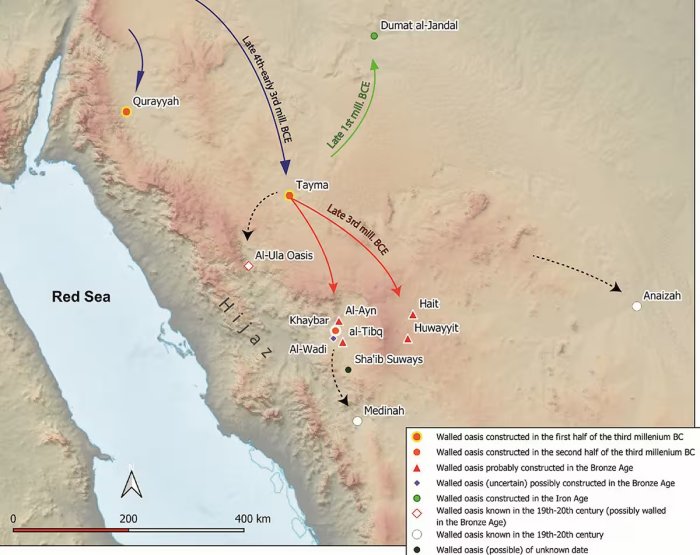Jan Bartek – AncientPages.com – Recent investigations in northwest Arabia have uncovered a fascinating network of monumental walls enclosing many major oases in the region.
A walled oasis, a concept recognized since at least the early twentieth century, refers to an oasis encircled by outer walls. These extensive defensive structures safeguarded settlements, water sources, livestock such as goats and sheep, and crops including cereals, fruits, and date palms from as early as the second millennium BC. The construction and upkeep of these outer walls required considerable investment from local communities for their protection and display of power.
The Walled Oasis Complex in north-west Arabia is characterized by its distinct geographic distribution. This region features a series of fortified settlements strategically located to maximize access to water resources and arable land. The oases are spread across the desert landscape, forming a network that supported ancient trade routes and facilitated cultural exchanges. Credit: G. Charloux
An international team of archaeologists has reported that identifying this Walled Oases Complex in northwest Saudi Arabia represents a transformative shift in understanding the socioeconomic evolution of this vast and largely unexplored region
This remarkable network of walled oases, some over 4,000 years old, demonstrates a sophisticated survival strategy within one of Earth’s most challenging environments: the Arabian Desert.
According to a recent study published in the journal Antiquity, six walled oases were identified within a north-west Arabian complex. While archaeologists have long been aware of the walled oases at Tayma and Qurayyah, four additional sites—Dumat al-Jandal, Hait, Huwayyit, and Khaybar—were discovered through satellite imagery and subsequently confirmed. These oases in northwestern Saudi Arabia were protected by walls extending up to eight kilometers in length. Within these fortified areas were genuine cities that housed crops, water wells, and herds of goats and sheep.
3D reconstruction of the Late Iron Age western enclosure in Dumat al-Jandal walled oasis. Credit: Dumat al-Jandal Archaeological Project; figure by M. Bussy & G. Charloux).
The walls served not only as defensive structures but also as symbols of power due to the significant collective effort required for their construction and maintenance over centuries. Archaeologist Guillaume Charloux explains that these walls were up to two meters thick and featured watchtowers. They were renewed by successive generations, highlighting their enduring importance throughout history.
The discovery of ancient walled oases, such as those in Tayma and Qurayyah, reveals a sophisticated network that dates back 5,000 years. This network comprises at least ten oases stretching from Tayma near Jordan to Thaj on the Persian Gulf. Remarkably, these structures have endured since the Bronze Age (3000–1200 BCE), likely influenced by Mediterranean Levant techniques. During the Iron Age (1200–550 BCE), these oases expanded further and continued to evolve, reaching their peak in Roman times, when they extended into eastern Arabia.
Researchers highlight that these walled oases were not solely for defense but represented a model of socioeconomic development where political entities took control of fertile landscapes. These authorities established fortified towns as early as the Bronze Age and constructed substantial outer walls in a single phase. Many of these structures stood for centuries, playing a pivotal role in the development of North-Arabian caravan kingdoms and increasing social complexity during the Iron Age.
The walled oasis of al-Ayn reconstructed on Google Earth (A), and aerial views of the rampart (B) with abutted bastion (C) and inner masonry (D). Credit: G. Charloux.
In more recent history, particularly during the nineteenth and twentieth centuries, this static oasis model effectively protected rural areas from tribal raids. This finding challenges previous perceptions of Arabia as merely desert terrain dominated by Bedouins and illustrates that complex sedentary societies existed there 5,000 years ago—societies shaped by trade dynamics, climate changes, and advancements in military technologies.
“This enduring model of rural occupation in the north-west Arabian desert exhibits notable variations over time and space, reflecting different collective strategies.
See also: More Archaeology News
It was notably affected by multiple factors, including environmental fluctuations, technological and socioeconomic developments, and changes in settlement dynamics, caravan trade and defensive practices. Despite current limitations in the understanding of local fortification systems, including their dating and means of construction, the discovery or confirmation of new walled oases underscores the need for further archaeological exploration of this millennia-old phenomenon in north-west Arabia and in other desert contexts,” the study concludes.
The study was published in the journal Antiquity
Written by Jan Bartek – AncientPages.com Staff Writer




